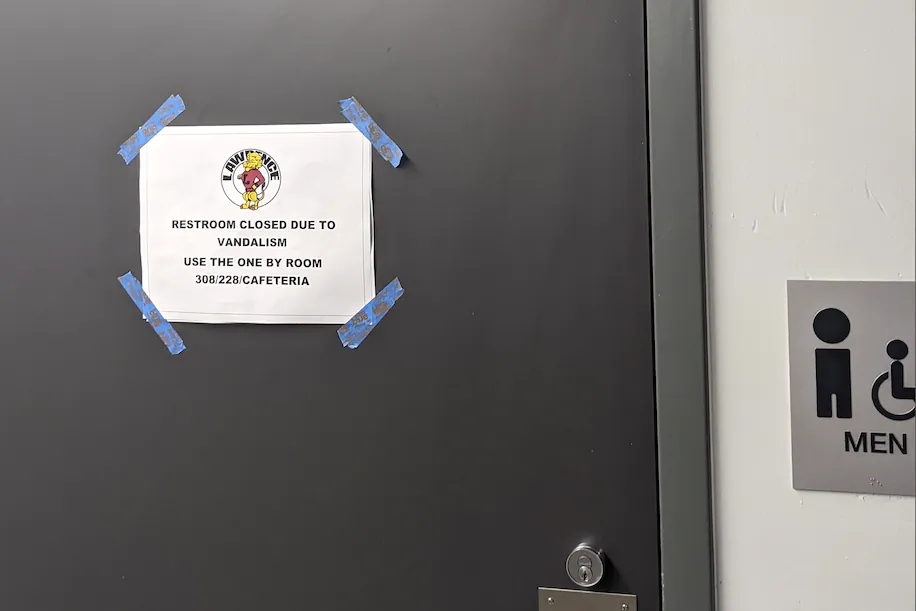The next day, I got an email from his middle school, telling us that the bathrooms had been vandalized as part of this trend.
In fact, parents all across the country are getting emails and notes from schools, warning them about this trend, and asking them to talk to their kids about the potential consequences.
Teachers are posting memes on social media about it, tweeting about it, begging parents to intervene. School principals have started requiring students to keep their phones on their desks when they go to the bathroom so they can’t record themselves.
This twisted trend started with a kid stealing masks from school and is now costing thousands of dollars in bathroom and locker room repairs. Urban Dictionary describes a “lick” as “a successful theft which results in an acceptable, impressive, and rewarding payday for the protagonist.” The most common licks in this challenge are stealing soap dispensers, ripping up lockers and damaging toilets.
(In a weird twist in this weird trend: GP Pro, which manufactures soap dispensers, along with other items being destroyed in this challenge, is offering to replace paper towel, toilet tissue and soap dispensers to schools for free through the end of September.)
While the videos may not show the perpetrators’ faces, they’re hardly anonymous. Teens have been identified, by voices and through responsible friends, and arrested because of their behavior.
TikTok has since banned the videos, along with the hashtag and related tags, but that has done little to slow this trend. Kids are savvy when it comes to technology, and by simply changing the spelling of a hashtag, they can continue to post this type of content. Also, this doesn’t mean there won’t be more of these types of challenges. The Devious Lick challenge is just one in a long line of social media-driven challenges that promote risky, dangerous and sometimes deadly behavior. Like the Tide Pods challenge, or more recently, the Crate Challenge.
So why do these types of risky trends have so much steam with teenagers in particular? Claire Crooks, psychologist, director of the Center for School Mental Health at Western University and co-author of “Adolescent Risk Behaviors: Why Teens Experiment and Strategies to Keep Them Safe,” describes these types of challenges as the perfect storm combining the lag in the development of the prefrontal cortex during the teenage years and the children’s need for community and belonging, as well as the dopamine rush from likes, comments and views. “These trends play directly into how adolescent brains are wired.”
Along with the wiring of the teenage brain, Kaitlynn Mendes, an associate professor of sociology at Western University who is focused on online risk and harm that young people faced during coronavirus shutdowns, attributes the popularity of these trends to an “ ‘always-on’ culture, where young people feel pressure to gain visibility, likes and shares because it’s part of how they earn social capital within their friend groups.”
As teens idolize social media influencers, many of whom have lucrative careers and endorsement deals, the idea that one video could make them a viral sensation is not that far-fetched.
As a parent of four tweens and teens myself, it sounds like we’re up against a lot of biology and sociology when it comes to handling these types of trends. However, Diana Graber, author of “Raising Humans in the Digital World” and the founder of Cyber Civics, says that there are preventive measures parents can take when it comes to inoculating their kids against these challenges, as well as other online situations that they will inevitably encounter.
First, it’s important for kids to understand their digital reputation, and how it can affect them later in life. “We know that colleges and employers are looking at social media accounts, either directly by checking themselves, or even indirectly, if someone brings an account to their attention,” Graber says. Simply put, if kids engage in these types of behaviors online, they may not get into their college of choice, and they may not get the job they want.
Graber said it’s important for kids and parents to read the community guidelines of the apps they are using. It’s definitely a time-consuming activity, but caregivers can remind kids that when they sign up for social media, they also enter into a contract and agree to terms. Think of it this way: We follow the age limit and other guidelines for opening a bank account, but we shrug off the limits for apps on which kids are spending hours of their time each day. It’s imperative that parents and kids read the fine print because, as Graber wisely notes, “if you think TikTok is going to take care of your child, they’re not.”
And finally, Graber emphasizes that kids need to know what it means to be a good digital citizen. “Kids know how to be a good citizen in the real world — honest, respectful, compassionate — but then they go online and suddenly those things go right out the window,” she says, going on to say kids need to understand the expectations of their online communities just as much as they know the ones for their real-life communities.
The Devious Lick challenge isn’t the first of these types of social media trends, and it certainly won’t be the last. Teens will continue to engage in risky behaviors, now with the extra push of social media egging them on.
Whether your kids are already engaging in these types of social media challenges or not, the No. 1 prevention strategy for these types of behaviors is actually a positive relationship with a caring parent or adult.
Mendes, Crooks and Graber agreed that if anything happens, you want your teens to be able to come talk to you in a safe, healthy environment, where the lines of communication always remain open and nothing is off limits.
And that, parents, is on us.
Kristen Mei Chase is a writer, author, mom of four and co-founder of Cool Mom Picks.







